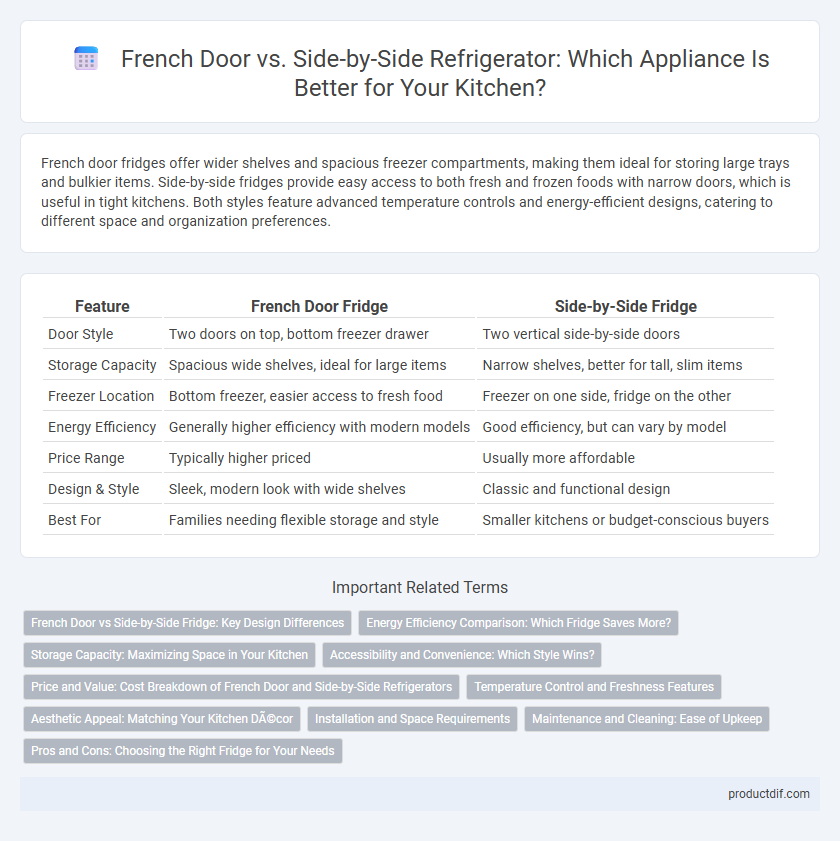French door fridges offer wider shelves and spacious freezer compartments, making them ideal for storing large trays and bulkier items. Side-by-side fridges provide easy access to both fresh and frozen foods with narrow doors, which is useful in tight kitchens. Both styles feature advanced temperature controls and energy-efficient designs, catering to different space and organization preferences.
Table of Comparison
| Feature | French Door Fridge | Side-by-Side Fridge |
|---|---|---|
| Door Style | Two doors on top, bottom freezer drawer | Two vertical side-by-side doors |
| Storage Capacity | Spacious wide shelves, ideal for large items | Narrow shelves, better for tall, slim items |
| Freezer Location | Bottom freezer, easier access to fresh food | Freezer on one side, fridge on the other |
| Energy Efficiency | Generally higher efficiency with modern models | Good efficiency, but can vary by model |
| Price Range | Typically higher priced | Usually more affordable |
| Design & Style | Sleek, modern look with wide shelves | Classic and functional design |
| Best For | Families needing flexible storage and style | Smaller kitchens or budget-conscious buyers |
French Door vs Side-by-Side Fridge: Key Design Differences
French door fridges feature a bottom freezer and wide double doors for the refrigerator compartment, maximizing usable space and accessibility. Side-by-side fridges have vertically split compartments, placing the freezer and refrigerator side by side with narrow doors that suit tight spaces. French door models often offer more flexible storage options and a larger fresh food section, while side-by-side designs provide better organization with separate freezer access.
Energy Efficiency Comparison: Which Fridge Saves More?
French door fridges generally offer better energy efficiency compared to side-by-side models due to their wider shelves and less cold air loss when opening one door. Energy Star-certified French door refrigerators can consume about 10-20% less electricity annually, making them more cost-effective over time. Side-by-side fridges often split freezer and fridge sections vertically, leading to more frequent door openings and greater energy consumption.
Storage Capacity: Maximizing Space in Your Kitchen
French door fridges typically offer larger storage capacity with wide shelves and spacious drawers, ideal for storing bulky items and fresh produce efficiently. Side-by-side fridges provide vertical storage with slim freezer and fridge compartments, optimizing narrow spaces but often with less overall storage volume. Choosing between these designs depends on your kitchen layout and need for maximizing accessible, organized space for perishable goods.
Accessibility and Convenience: Which Style Wins?
French door fridges offer superior accessibility with wide shelves and a spacious bottom freezer, making it easier to store and reach large items. Side-by-side fridges provide convenient vertical organization with narrow doors that fit well in tight spaces but may limit freezer and fridge width. When prioritizing ease of access and convenience, French door models generally outperform side-by-side designs due to their flexible storage options and ergonomic layout.
Price and Value: Cost Breakdown of French Door and Side-by-Side Refrigerators
French door refrigerators typically range from $1,500 to $3,000, offering spacious interiors and flexible storage options that justify their higher price. Side-by-side models usually cost between $1,200 and $2,500, providing convenient access to both freezer and fridge compartments but with narrower shelves. When evaluating value, French door fridges often deliver better energy efficiency and advanced features, making them a cost-effective choice over time despite the initial higher investment.
Temperature Control and Freshness Features
French door fridges offer superior temperature control with multiple cooling zones and dual evaporators, allowing precise regulation to maintain optimal freshness for fruits, vegetables, and dairy. Side-by-side fridges typically feature a single cooling system, which can lead to uneven temperature distribution affecting food preservation. Advanced freshness features in French door models, such as humidity-controlled crispers and air purification systems, further enhance food quality compared to the more basic systems found in side-by-side designs.
Aesthetic Appeal: Matching Your Kitchen Décor
French door fridges offer a sleek, modern look with wide shelves and minimalistic handles that enhance contemporary kitchen designs. Side-by-side fridges provide a balanced, symmetrical appearance with vertical doors, complementing traditional and transitional decor styles. Choosing the right style depends on coordinating door finishes, hardware, and overall kitchen color schemes for cohesive aesthetic appeal.
Installation and Space Requirements
French door fridges require wider cabinet openings due to their double-door design but allow for better access to fresh foods with spacious interior layouts, making them ideal for kitchens with ample space. Side-by-side fridges have a narrower door swing, requiring less clearance, which is beneficial for tight kitchen layouts but may restrict access to wider items on the shelves. Proper measurement of door clearance and ventilation space is essential for both types to ensure efficient installation and optimal refrigerator performance.
Maintenance and Cleaning: Ease of Upkeep
French door fridges offer easier maintenance with wider shelves and fewer crevices, allowing for quick cleaning and straightforward access to all compartments. Side-by-side fridges typically have narrower shelves and multiple door seals, which can accumulate dirt and require more frequent, detailed cleaning. Choosing a French door model reduces upkeep time and effort, making it a practical option for simpler maintenance routines.
Pros and Cons: Choosing the Right Fridge for Your Needs
French door fridges offer wide, spacious shelves and better organization with multiple compartments, making them ideal for families who prioritize easy access and energy efficiency, while side-by-side fridges provide narrow door openings suitable for tight kitchens and often include built-in water and ice dispensers. However, French door models typically require more clearance space and can be more expensive, whereas side-by-side fridges may have narrower storage bins and sometimes limited capacity for wide items. Evaluating kitchen layout, storage preferences, and budget helps in selecting the fridge that best meets specific household needs and lifestyle.
French Door Fridge vs Side-by-Side Fridge Infographic

 productdif.com
productdif.com